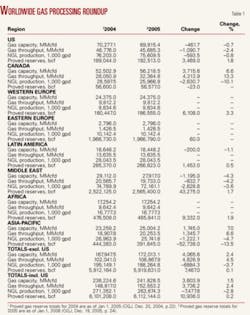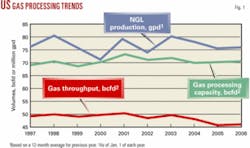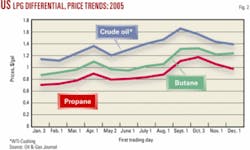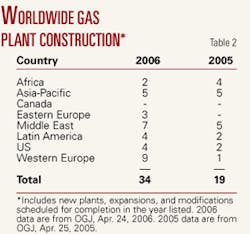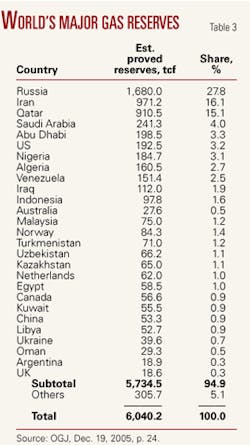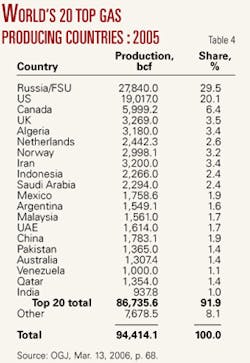Declining natural gas production in Canada and the US in 2005 combined with robust growth elsewhere in the world to tip the balance of worldwide gas processing activity away from its historic center for the first time.
The largest influence on gas processing in North America in 2005 is by now an oft-told story: The major gas production and processing belts of the US-the Mississippi, Louisiana, and Texas coastlines on the Gulf of Mexico-were blasted by two massive hurricanes last year. The storms shut in much of the region’s production and processing for the rest of the year.
Natural gas production in the US and Canada dipped sharply in 2005 (OGJ, Mar. 13, 2006, p. 68). Healthy processing gains in Canada, however, could not prevent the two countries’ industries from falling from their leading position among the world’s gas processing regions. Also playing a major role in the trend were large increases east of the Suez Canal (Table 1), based on growing natural gas production there.
These trends are evident in the latest data from Oil & Gas Journal’s annual survey of the world’s gas processing companies.
Highlights
The historic tip in 2005 has been long in coming (OGJ, June 27, 2005, p. 45) but received a huge push not only from the storms but also from natural gas production hikes in Eastern Europe, Africa, the Middle East, and countries of Asia and the Pacific area as these countries ramped up to meet increased demand in Western Europe and the US.
In the countries of Eastern Europe, including Russia and states of the former Soviet Union, gas production in 2005 jumped 2.8 tcf (10.4%) over 2004. In the Middle East, the gain was nearly 2 tcf (24%); in the countries of Asia-Pacific, more than 7 bcf (6.5%); and in Africa, more than 433 bcf (9.5%; OGJ, Mar. 13, 2006, p. 68; Mar. 14, 2005; p. 67).
Much of this new production flowed into the growing LNG trade. New LNG export capacity in Egypt, Qatar, Malaysia, and Australia came on stream in the 30 months leading up to Mar. 30, 2006, along with new Atlantic Basin LNG supplies from Trinidad and Tobago and Nigeria.
Declining natural gas production begets declining NGL production: Canada and the US combined in 2005 to produce slightly more than 33% of the world’s NGL, off from more than 34% in 2004, more than 40% in 2003, and 42% in 2002.
Adding Mexican data to those for the US and Canada (removing Mexico for the exercise from the Latin America column) reveals that North America holds:
- Barely 52% of the world’s processing capacity, down from more than 53% for 2004, nearly even with 52% in 2003, but still off from 54% in 2002 and 55% in 2001.
- 38% of the world’s NGL production, down from more than 43% in 2004, sliding from 46% in 2003, 48% in 2002, and nearly 52% for 2001.
Canadian natural gas production, despite dropping in 2005, appears more likely to resume growth if only for the near term, driven by Alberta’s heavy-oil production needs and US Lower 48 demand. Mexico’s production is also rising, by more than 85 bcf in 2005.
Both countries also have LNG terminals under construction or planned; Mexico will start up its Altamira terminal later this year on the Gulf of Mexico. Those imports will mostly translate into net exports to the US, as natural gas production there seems inexorably in decline and with it, the natural gas processing industries.
On Jan. 1, 2006, OGJ data show that US gas processing capacity stood at nearly 70 bcfd, essentially flat compared with 2004; throughput in 2005 averaged more than 46 bcfd, off from 2004; and NGL production, more than 76 million gpd (more than 1.8 million b/d; Fig. 1), again essentially flat compared with 2005.
Fig. 2 shows pricing differentials in the US between LPG-the most widely traded NGL on the world market-and crude oil for the first trading day of each month in 2004. The chart shows the historically normal relationship between LPG and crude oil continued throughout 2005. (An accompanying article, beginning on p. 60, discusses international trade in LPG and ethane and the NGL production implications from the growing LNG trade.)
null
Sources
Oil & Gas Journal’s exclusive, plant-by-plant, worldwide gas processing survey and its international survey of petroleum-derived sulfur recovery provide industry activity figures.
Canadian data are based on information from Alberta’s Energy and Utilities Board that reflect actual figures for gas that moved through the province’s plants and are reported monthly to the AEUB. For 2000 for the first time, OGJ took these data for all of Alberta and compiled annual figures and thereby created a new baseline for data comparisons thenceforth.
In addition to AEUB figures for Alberta and to operator responses to its annual survey, OGJ has supplemented its Canadian data with information from the British Columbia Ministry of Employment & Investment’s Engineering and Operations Branch and the Saskatchewan Ministry of Energy & Mines.
Gas processing capacity outside Canada and the US as 2006 began stood at more than 126 MMcfd, up from nearly 115.5 bcfd in 2004; throughput for 2005 averaged more than 81 bcfd, up from nearly 74 bcfd in 2004; and NGL production in 2005 outside the US and Canada averaged more than 201million gpd, well ahead of the 2004 pace of more than 166.5 million gpd.
Note that in Table 1, the growth in NGL production for Asia-Pacific derives mainly from new condensate production figures from North West Shelf Venture.
The current state of gas plant construction in the world appears in Table 2, based on OGJ’s worldwide construction surveys. Table 3 ranks the world’s major natural gas reserves by country at the start of 2006; Table 4, the world’s top natural gas producing countries for 2005; and Table 5, the world’s leading NGL producers.
Hurricanes; projects
Natural gas production and processing in the US, already constrained by political and environmental pressures that have restricted access to prospective new areas, needed no additional impediments in 2005; they got them anyway in late August and again in late September.
On Monday, Aug. 29, Hurricane Katrina rolled over the Mississippi and Louisiana coastlines, the eye passing just east of New Orleans. The human devastation was huge, crippling the city of New Orleans and points eastward to Biloxi, Miss., for years to come.
The toll on gulf natural gas production and related land-based processing became apparent only after companies could get employees and workers back to where offshore rigs had last been seen and to sites on land of flooded processing vessels and twisted piping (see cover inset photograph).
By early October, a grim picture began to emerge: The US Minerals Management Service reported 6.4 bcfd of natural gas production-64.4% of normal production from the gulf-remained shut in. Through Oct. 7, more than 246 bcf of natural gas production had been lost.
The US Department of Energy reported at least 100 MMcfd of capacity at 20 gas plants were still idle in early October. In addition, capacity of more than 4.7 bcfd could operate but was idle because of infrastructure damage or lack of natural gas supply (OGJ Online, Oct. 10, 2005).
Less than a month later, category-3 Hurricane Rita plowed ashore over the Sabine River that splits Louisiana from Texas. By yearend 2005, 23% of daily natural gas production in the hurricanes’ paths remained shut in (OGJ, May 1, 2006, p. 38).
US gas processing may recover and reassert its dominance among the world’s gas producing countries and lead North American capacity back, but the immediate future as 2006 began was not promising.
Selected activity
Enterprise Products Partners LP, Houston, last year expanded its 210,000-b/d NGL fractionator at Mont Belvieu, Tex., by 15,000 b/d and is building a 60,000-b/d fractionator to accommodate increased NGL production from Rocky Mountains (OGJ Online, Jan. 18, 2005).
In late 2005, MarkWest Energy Partners LP, Denver, announced it would spend $355 million to buy the 142-MMcfd Javelina Co. gas processing and fractionation plant in Corpus Christi, Tex., from El Paso Corp., Kerr McGee Corp., and Valero Energy Corp.
The gas processing plant gathers, treats, and processes about 130 MMcfd of off-gas streams from six refineries around Corpus Christi (OGJ Online, Sept. 29, 2005).
Also late last year in Alberta, Altagas Income Trust, Calgary, announced plans to construct, own, and operate a 20-MMcfd sour-gas processing plant near Princess. The plant, which was to have started up by yearend 2005, processes production from the northern portions of Gentry Resources Ltd.’s Princess fields.
An existing 30-km sour-gas gathering system links the Princess plant to the existing Bantry plant. The additional processing capacity aimed at freeing up Princess-area production (OGJ Online, Oct. 7, 2005).
In Africa, Badr Petroleum Co. (Bapetco), jointly owned by Egyptian General Petroleum Corp. and Shell Egypt NV, planned three projects related to the 300-MMscfd Obaiyed gas plant in Egypt.
The Qasr gas field was tied in to the Obaiyed plant, the capacity of which was boosted to 420 MMscfd (OGJ Online, Feb. 23, 2005).
In Nigeria, Global Gas & Refining Ltd., a Nigerian subsidiary of Houston-managed Global Energy Inc., started up its barge-mounted, 120-MMcfd Cawthorne Channel gas processing plant in the Bonny River area.
Shell Petroleum & Development Co. of Nigeria Ltd. supplies 80 MMcfd of associated gas from its Cawthorne Channel and Awoba fields to the plant. Global is extracting liquids and returning residual gas to Shell for delivery to Nigeria LNG Ltd.’s facility at Bonny.
Initially processed liquids were shipped via the 75,000-cum Berge Okoloba Toru floating production, storage, and offloading vessel to the US for fractionating at Mont Belvieu. Since first quarter this year, however, Global’s fractionator aboard the FPSO has been handling the liquids in country (OGJ Online, July 6, 2005).
In another floating processing scheme, this time in Asia, GAIL (India) Ltd. announced earlier last year plans to invest $340 million to build a floating gas plant in Myanmar. Commissioning targets second-quarter 2006.
GAIL planned to install the barge-mounted plant in 340 ft of water in Yetagun gas field, 260 miles south of Yangon in the Gulf of Martaban off Myanmar. It would produce 250,000 tonnes/year of LPG from about 11.3 million cu m/day of gas. After liquids removal, lean gas from the plant will go to Thailand (OGJ Online, Mar. 1, 2005).
Busy Middle East
Much of last year’s plans and activity centered in the Middle East.
At mid-year, Abu Dhabi Gas Industries Ltd. hired Foster Wheeler International Corp. to build and commission Gasco’s third NGL train at Ruwais, Abu Dhabi.
The work is part of other Gasco projects that include a new gas plant at Asab (AGD-II) and the Onshore Gas Development project (OGD-III facilities) at Habshan field.
With targeted start-up of first-quarter 2008, the third train at Ruwais will process NGL transported by new pipeline from OGD-III and AGD-II, supplemented by a new LPG stream from the nearby Takreer refinery.
A 24,400-tonne/day fractionation and treatment train will process the NGL into ethane, LPG, and C5+. The project includes four 83,600-cu m LPG storage tanks, one 76,000-cu m C5 storage tank, and a two-berth extension to the export jetty.
Later in the year, Gasco hired Fluor Corp. for the planned 1.3-bcfd expansion of the 1.04-bcfd Habshan gas complex in Abu Dhabi.
Included are the installation of two sulfur-recovery units with total capacity of 1,600 tpd, installation of an acid-gas enrichment unit, increase of the capacity of the pressure-boosting units to feed the additional associated gas from Bab oil field for processing, and upgrade of the distributed control system.
Targeted start-up is mid-2008 (OGJ Online, May 16, and Nov. 3, 2005).
In nearby Oman, the Ministry of Oil & Gas let a $200-million EPC contract for construction of a 20-MMcfd, single-train separation plant at Kauther gas field in the north. Petroleum Development Oman (PDO) operates the Al Dakhlia region field.
Conditioned gas from the plant will flow into the domestic gas system. Condensate will be transported to the Saih Rawl central processing plant (OGJ Online, Aug. 1, 2005).
And in Saudi Arabia late last year, Saudi Aramco started building its Hawiyah gas processing plant near Ghawar oil field south of Dhahran (OGJ Online, Mar. 21, 2005).
The plant will be able to process 4 bcfd of gas to produce 310,000 b/d of ethane and NGL as feedstock for the industrial centers at Jubail on the Persian Gulf and Yanbu on the Red Sea. Aramco expects completion in early 2008.
Construction in addition to the plant includes three NGL recovery trains, product surge and shipping facilities, utilities, tank and process control system, gas treating and sales gas compression, inlet distribution, two gas treating trains, and electrical system and support facilities.
As part of the Hawiyah NGL recovery program, the Ju’aymah gas fractionation plant will expand with a fourth train to fractionate 270,000 b/d of ethane and NGL and 100,000 b/d of propane and NGL.
And late last year, Saudi Aramco let contracts for 13 Superclaus sulfur-recovery units at three gas plants in the kingdom. The units will allow Aramco to achieve sulfur recovery of 98.7%. The Kursaniyah plant will add three 900 tpd SRUs. The Shedgum and Uthmaniyah facilities will each revamp five 550-tpd units (OGJ Online, Dec. 2, 2005).
Across the Persian Gulf, National Iranian Gas Co. awarded a 4-year, $1.6 billion contract to build the Bid Boland II gas processing plant in southwestern Iran.
The plant, in Khuzestan Province 15 km from Behbahan City, will process up to 2 bcfd of sweet and sour associated gas plus condensates and LPG.
The plant’s treated gas will be fed into the national IGAT (Iran Gas Trunkline) pipeline network, while ethane will serve as feedstock to the nearby Arvand petrochemical complex. The LPG will be stored in a storage facility to be built at Mahshahr, 100 km away, and exported for sale.
The Bid Boland I gas plant, has been processing 800 MMcfd of associated gas since the early 1970s (OGJ Online, June 28, 2005).
Sulfur production
Worldwide refining and natural gas processing’s production of petroleum-derived sulfur in 2005 slid to slightly less than 85 million tpd, from just more than 85 million tpd in 2004. Capacity held level at slightly more than 178 million tpd.
Canada and the US continued to dominate last year with 47% of processing capacity and 49% of actual production; both figures are down from 2004.
Canada produced nearly 23.4 million tpd, down slightly from 2004. US production also slipped, by nearly 1 million tpd, to slightly more than 18.5 tpd.
Canada accounted for less than 24% of the overall total capacity and more than 27.5% of production.
Click here to download a PDF of the Worldwide Gas Processing table from page 59.
OGJ subscribers can download, free of charge, the 2006 Worldwide Gas Processing Survey tables at www.ogjonline.com: Click on Resource Center, Surveys, OGJ Subscriber Surveys, then Worldwide Gas Processing, and choose from the list below June 26, 2006. To purchase spreadsheets of the survey data, please go to http://www.ogj.com/resourcecenter/orc_survey.cfm or email [email protected].
